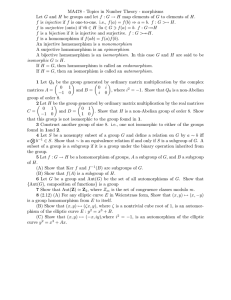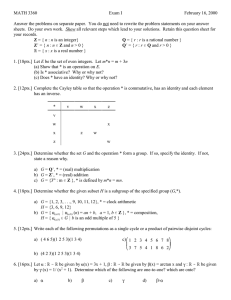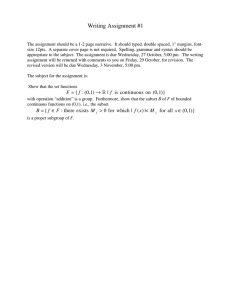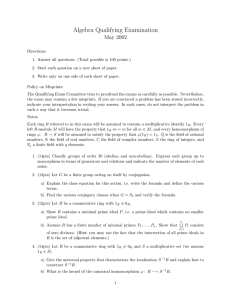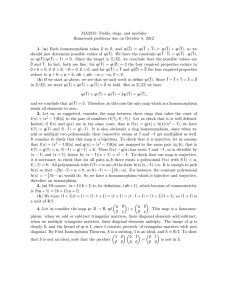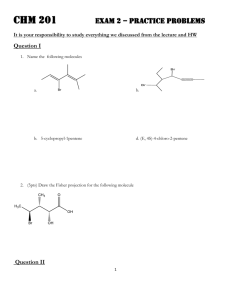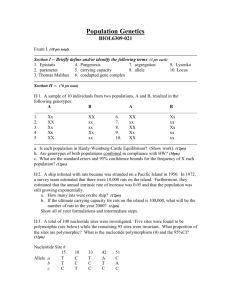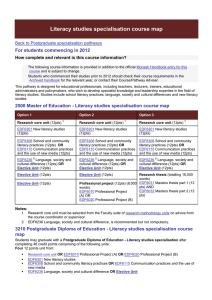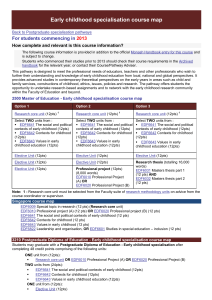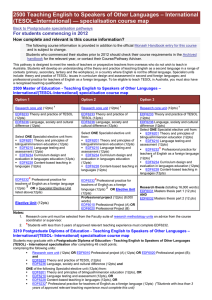Algebra Qualifying Examination January 2002
advertisement
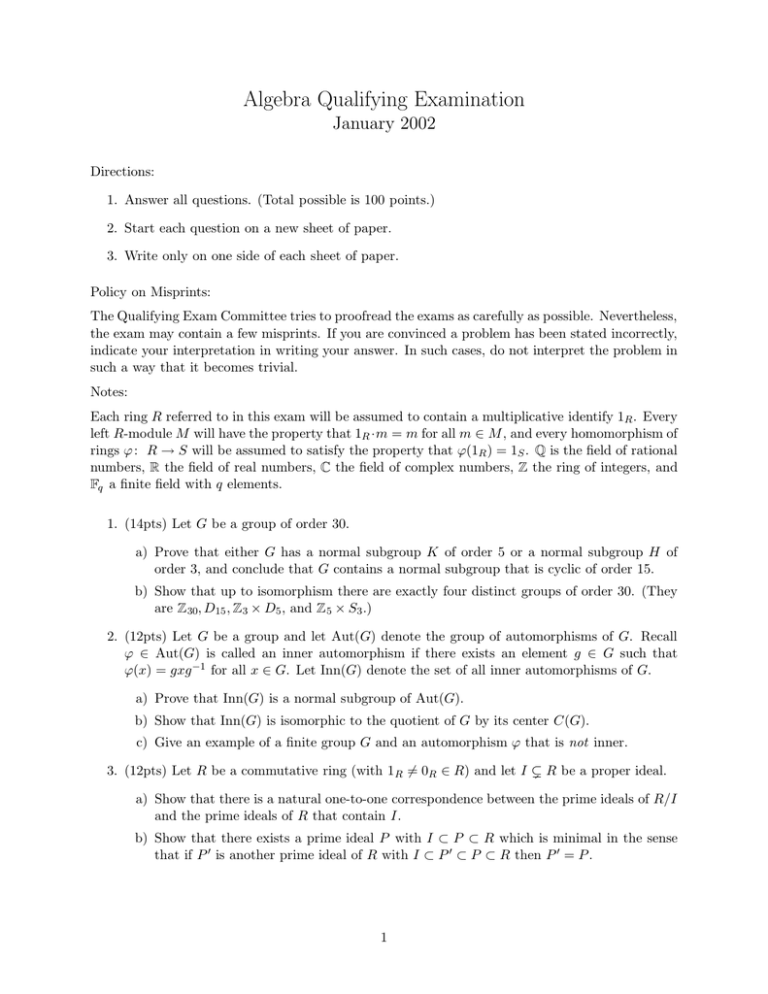
Algebra Qualifying Examination
January 2002
Directions:
1. Answer all questions. (Total possible is 100 points.)
2. Start each question on a new sheet of paper.
3. Write only on one side of each sheet of paper.
Policy on Misprints:
The Qualifying Exam Committee tries to proofread the exams as carefully as possible. Nevertheless,
the exam may contain a few misprints. If you are convinced a problem has been stated incorrectly,
indicate your interpretation in writing your answer. In such cases, do not interpret the problem in
such a way that it becomes trivial.
Notes:
Each ring R referred to in this exam will be assumed to contain a multiplicative identify 1R . Every
left R-module M will have the property that 1R ·m = m for all m ∈ M , and every homomorphism of
rings ϕ : R → S will be assumed to satisfy the property that ϕ(1R ) = 1S . Q is the field of rational
numbers, R the field of real numbers, C the field of complex numbers, Z the ring of integers, and
F q a finite field with q elements.
1. (14pts) Let G be a group of order 30.
a) Prove that either G has a normal subgroup K of order 5 or a normal subgroup H of
order 3, and conclude that G contains a normal subgroup that is cyclic of order 15.
b) Show that up to isomorphism there are exactly four distinct groups of order 30. (They
are Z30, D15 , Z3 × D5 , and Z5 × S3 .)
2. (12pts) Let G be a group and let Aut(G) denote the group of automorphisms of G. Recall
ϕ ∈ Aut(G) is called an inner automorphism if there exists an element g ∈ G such that
ϕ(x) = gxg−1 for all x ∈ G. Let Inn(G) denote the set of all inner automorphisms of G.
a) Prove that Inn(G) is a normal subgroup of Aut(G).
b) Show that Inn(G) is isomorphic to the quotient of G by its center C(G).
c) Give an example of a finite group G and an automorphism ϕ that is not inner.
3. (12pts) Let R be a commutative ring (with 1R 6= 0R ∈ R) and let I
( R be a proper ideal.
a) Show that there is a natural one-to-one correspondence between the prime ideals of R/I
and the prime ideals of R that contain I.
b) Show that there exists a prime ideal P with I ⊂ P ⊂ R which is minimal in the sense
that if P 0 is another prime ideal of R with I ⊂ P 0 ⊂ P ⊂ R then P 0 = P .
1
4. (14pts) Let R be a commutative ring with 1R ∈ R. An R-module I is said to be injective if,
given any diagram of R-module homomorphisms
g
0 −→ A −→ B
f↓
I
with the top row exact (i.e. g a monomorphism), there exists an R-module homomorphism
h : B → I such that h ◦ g = f
0
A
f
g
B
h
I
It can be shown that every R-module may be embedded in an injective R-module.
a) Show that the following are equivalent:
1) I is injective.
f
g
2) every short exact sequence 0 −→ I −→ B −→ C −→ 0 is split exact (i.e. B ∼
= I⊕C in
such a way that f and g become the canonical inclusion and projection respectively.)
3) I is a direct summand of any module B of which it is a submodule.
b) Show that I is injective if and only if for every ideal J ⊂ R, any R-module homomorphism
J → I may be extended to an R-module homomorphism R → I.
5. (12pts) Let Q = {z ∈ C s.t. ∃ a polynomial with rational coefficients, F (X) ∈ Q [X], of degree
≥ 1 with F (z) = 0}.
Q
Prove that Q
a) Prove that
is a field.
b)
is algebraically closed.
6. (12pts) Consider the polynomial X 5 − X + 1 ∈ F 5 [X]. Show that F (X) is irreducible and
determine the splitting field K over F 5 of F (X). Determine the Galois group Gal(K/F 5 ) and
explain how the Frobenius automorphism ϕ5 : K → K defined by ϕ5 (x) = x5 in Gal(K/F 5 )
permutes the roots of F (X).
7. (12pts) Let T : V → V be a symmetric operator on a real vector space V with an inner
product, i.e. a positive definite symmetric bilinear form h , i : V × V → R . Assume V is
finite dimensional. Show that there is an orthonormal basis of V consisting of eigenvectors of
T . (Recall a symmetric operator satisfies hv, T wi = hT v, wi for all v, w ∈ V .)
8. (12pts) Let R be a commutative ring with 1R ∈ R and M a Noetherian R-module (i.e.
every submodule of M is finitely generated, including M itself.) Suppose f : M → M is a
surjective homomorphism, prove that f is also injective. (Hint: Examine the kernels of the
iterates, f n : M → M , of f .)
2
